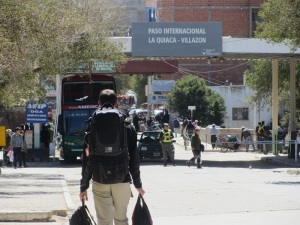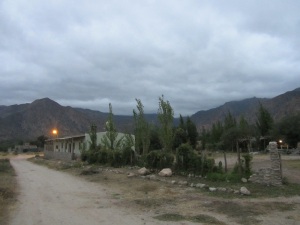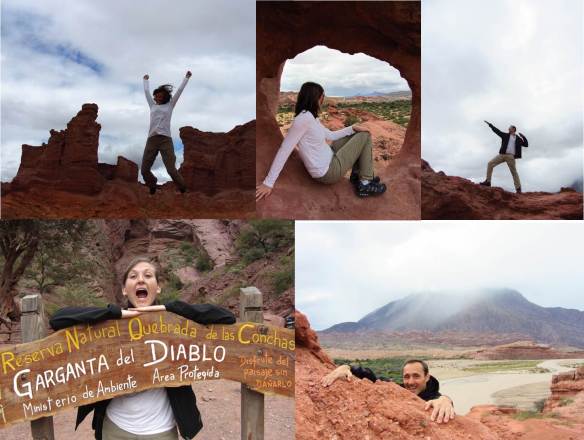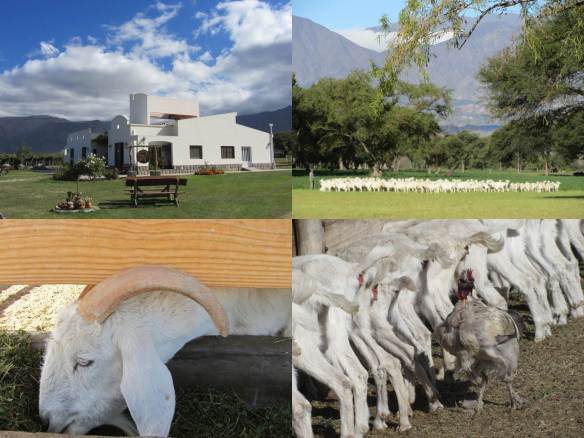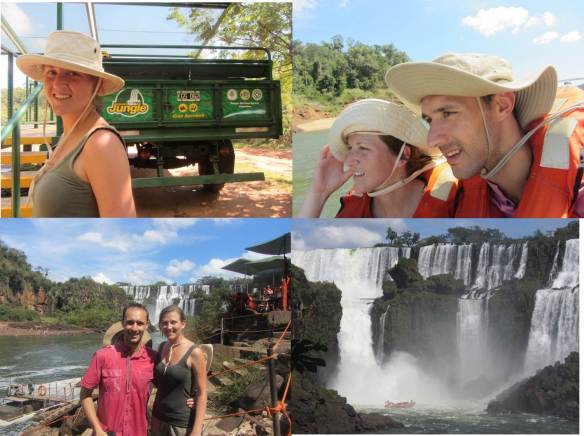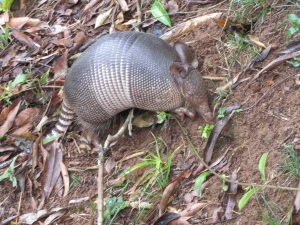Our first overnight bus experience in Argentina was good. Compared to long distance busses in South Africa, the cama bus was a very comfortable way of travelling 15 hours to Buenos Aires (much more comfortable than the 14 hour flight from Dubai). Obviously if you expect a hotel in the form of a bus, you will be disappointed, as it’s still a bus. The Via Bariloche busses seemed to be all fairly new and comfortable. To our surprise, the prices quoted currently are more than double the prices listed in the Lonely Planet guide book for Argentina, which made it difficult to stay within their on-a-shoe-string-budget of $35 pppd. The cama bus from San Ignacio to Buenos Aires was about AR$500 pp compared to the listed price of ±AR$170 in the guide book.
We arrived in Buenos Aires around 9 am the following morning. The original plan was to stay with a fellow CouchSurfer again, but unfortunately our host had to go on a business trip. We therefore booked a room in Reina Madre Hostel in the Palermo district of the city (as the couple from Denmark recommended). The hostel is a family-run hostel, with some semi-permanent students living there. I think we were the only backpackers in the hostel at the time. The family was friendly and helpful, and the hostel was very clean. We stayed in the double room the first night (for a good sleep after the bus journey) and can recommend it – very comfortable bed!
Later the afternoon we went on a city walking tour covering the area from the San Martin square to the Recoleta area. Our guide shared some interesting stories about the city’s people and the aristocratic era of Buenos Aires. At the start of our trip we saw a photographer taking some “arty” pictures of a crazy guy climbing onto one of the statues. The guy threw a rope over one the horses and climbed on the horse in his “adamsgewaad”. Hahaha. A couple of minutes later the police were on the scene… On the tour we saw some of the aristocrat palaces. Wow, we couldn’t believe that so many families (over a 100) lived in these mansions, like they were kings, with loads of servants, hosting parties, etc. Today, only 1 of the mansions is still privately owned (by an old couple). The rest of the palaces are now either owned by the government, or used as embassies, hotels or museums. Our guide also shared some info with respect to plastic surgery in Buenos Aires – some medical plans have one free plastic surgery every two years! Apparently, like the Brazilians, Argentines are very conscious about their bodies, especially the Porteños (citizens of Buenos Aires). According to our guide there occurs about “100 boob jobs per day, uhm, that means 200 new boobies a day…?!”. We did not see so many tattoos as in Brazil though. During our tour we also passed the most expensive hotel in Buenos Aires, namely the Alvear hotel, with a min of US$800 and max of US$10000 per night. Ouch. Buenos Aires has the face of a European city – a lot of the buildings look like French / Italian / British buildings. Most of the Porteños have a European background, and the rest of Argentina tend to call them snobs. We also visited the Malvinas memorial – the Argentinians maintain that the British illegally occupies the Falkland Islands (which they call the Malvinas) and in a recent war in 1982 against Britain, they lost over 600 soldiers of which most were 18 year old boys serving their one year mandatory service.

Top, from left to right – entrance to the Recoleta cemetary; the Franciscan church building at night (at the end of our city tour); one of the 100 aristocrat palaces. Bottom, from left to right – legend has it that if you drink from this fountain, you will return to Buenos Aires, Cobus was hopeful :-); the crazy art guy before he got naked; a soldier at the Malvinas memorial; the Portenos call this little Big Ben (?!), not sure what the British make of this!
The next day we went to visit the Recoleta cemetary. On our way we encountered some of the professional dogwalkers – how in the world they manage to walk 10 dogs of different sizes at the same time is still a mystery to us!

The dogwalker with his dogs
The Recoleta cemetery is basicly the graveyard for the elite families in the history of Buenos Aires and includes the grave of the famous Evita. The mausoleums of the different families are more like artworks than anything else. Some of the statues are really amazing. But I must admit, we found it so strange, it’s as if they think too much of themselves – not all of them were actually SO important and contributed to the country and it’s people in significant ways. The Evita mausoleum (Duarte family), on the other hand, was not so impressive as some of the others. But maybe it fits her legacy – she maintained that she was there for the people, and not for the rich.

Mausoluems in the Recoleta cemetary. Bottom right – the grave of Eva Peron.
After wandering through all the graves, we went next door to the Franciscan church. It contained some interesting religious art and history. We also found one of the Gregorian music chant books inside – Cool!

An original Gregorian chant music book
The next stop was one of the big parks in Buenos Aires for a picknick lunch. After lunch we visited the Evita Peron museum. Some of the quotations from her biography actually sounds like she was an amazing woman. There may be another side to the story as some Argentines maintain, but who will really know her true motives except she and her Creator. We especially liked the following quotations:
“I am the wife of the president of the Argentine people, but presidencies expire and in the end history does not remember a simple marriage bond, but rather an unselfish heart and an upright conscience.” – Eva Peron, L.R.A Radio Nacional, Feb 24th 1947
“…I’ve erected this institution for social welfare’s sake – depriving it of any trace of charity – in the hopes that it’d become a banner of social justice. The poor are not cared for out of mercy or commiseration, but because they are also Argentine citizens who find themselves in despair, but who are as much worthy of attention as the rest of the citizenry.” – Eva Peron, July 6th 1949

Evita museum. Left – this is a parrot, but it is not applicable.
On our way home, we found Geri in a park nearby the museum making some friends while playing his game 🙂

Geri and his “non-imaginary” friends in the park
We returned to our hostel, relaxing the rest of the day and only went out to buy some food at the supermarket. At this point Cobus was rather sick with the flu, so we had to take it easy. We also decided to stay in a double room until he was better before moving to a dorm room.
We had a slow start the next morning and went to the city centre at around 12pm where we had our own “walking tour”. In the subway, someone tried to pickpocket Cobus – luckily Cobus didn’t have anything in his pockets and he just stared at the guy. The pickpocket put on his sunglasses (weird in the subway) and got off together with his friend at the next stop. We think the sunglasses were some sort of sign, like “I’ve been caught out” or “a dud”. We saw the unimpressive Obelisco and the very impressive Teatro Colon (although we didn’t pay the ridiculous gringo fee to see the inside – a ticket to an opera the following Sunday would have cost less, but unfortunately we left one day too early). We saw the famous Casa Rosada (meaning Pink House) where Evita delivered some of her well known speeches (next to the Plaza 25 de Mayo). Around the plaza were several other historic buildings. We also stumbled across a fairly new museum next to Casa Rosada, with interesting facts about the political history of Argentina. Unfortunately everything was in Spanish, so we had a hard time making sense of it.

Top, from left to right – Teatro Colon; the Obelisk; the Congress building; Casa Rosada. Bottom, from left to right – Plaza 25 de Mayo (it seems like every town in Argentina has a Plaza 25 de Mayo); the Cathedral outside and inside.
We returned to our hostel later the afternoon in time for a quick shower before we went to La Viruta, a closeby milonga, for some tango lessons. The first tango lesson was at 7pm, and we were glad we went early since the group was small and it was easy to follow the instructions. We had a great time figuring out the most basic tango steps – although my toes didn’t enjoy it so much! The Argentines wake up from their siesta late in the afternoon and only go out after 9pm. The group was much bigger during the second tango lesson at around 10pm, and it was difficult to find ones way around the dance floor. We also had a salsa lesson which was lots of fun. There was supposed to be a tango show later that night, however, at around 1am the Portenos were still on the dance floor enjoying themselves while we, the gringos, were getting tired (their late night energy is probably thanks to their long afternoon siesta). We left before the show started and waited for a bus in the hostel’s direction. There were fewer busses heading at that time of the night and we were freezing, so we decided to jump on a bus that we thought were going in more or less the right direction. It turned out, however, that we were heading towards an area that, according to our hostel owner are very dodgy late at night. We got off as soon as possible, and took the first taxi we saw back to our hostel.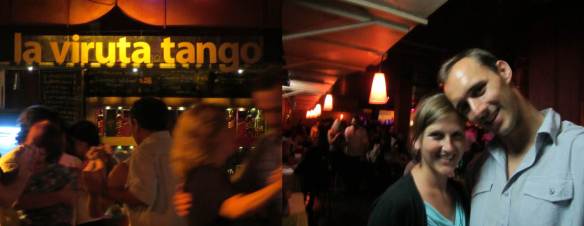
The next morning started almost the same than the previous – very late. The late night tango and Cobus’s flu was not a good combination. We only had a few objectives for the day, which included the Tango museum, the two famous landmarks Puente de la Mujer and Floralis Genérica, and an Argentine steak for dinner. It turned out that the Tango museum was closed for renovations, but next to the museum we found Café Tortoni, one of the recommended places to visit in Buenos. Cobus had his first submarino (warm milk in which you desolve a chocolate bar) -yummee.

Cafe Tortoni – they also host tango shows during the evenings
Next on the list was Puente de la Mujer. On our way there, we bought our first Havanna Alfajores, a must try in Argentina. Havanna makes some of the best Alfajores, which is basically dulce de leche (similar to caramel treat) between two cookies covered with meringue or chocolate.

Alfajores – yummee!
When we arrived at Puente de la Mujer, we realised it doesn’t look so impressive during the day compared to the pictures we’ve seen taken by night. Next on our list was the Floralis Genérica. We managed to find a bus close to the Obelisco going in the direction of the flower. The flower is an impressive piece of art. It opens in the morning at sunrise and close at sundown, mimicking a real flower. We concluded our last night in Buenos Aires with an Argentinian steak at La Doritas. We ordered the special 600g steak for two with salsa, papas fritas and salad. Although it was very tender and perfectly prepared, we were not overly impressed as the meat lacked flavour (maybe our expectation was too high). We’ve had much more tasty steaks in South Africa, but it is possible that we ordered a less tasty cut – in Argentina they don’t have the same cuts than elsewhere. It is difficult to distinguish for example between sirloin and fillet. The bus journey home was less “eventful” than the previous night’s wild goose chase, and it was not long before we were safe and sound in bed.

Puente de la Mujer, Floralis Generica, and Cobus enjoying his steak.
Our last day in Buenos Aires was reserved for the two Buenos Aires suburbs San Telmo and La Boca. We only had until 4pm before we had to return to our hostel to pick up our luggage and head for the bus terminal. In San Telmo we quickly realised that nothing really happens there, except on Sundays when there is an antique market. We decided to go onwards to La Boca straight away and found it much more alive (with the sound of music, la la la la, hehe. No really, there was a lot of music). The bus dropped us off just in time to see the last part of a live Tango street performance. Cool! We spent some time walking through the open air museum and market, on the way buying a different brand of Alfajores which was almost as tasty as the Havanna brand. The tourist section of La Boca is definitely worth a visit – colourful buildings, live music and tango, and in general a nice vibe. According to a small museum, the sailor community of La Boca used the left over paint of ships to paint their houses – usually one colour was not enough for a whole building and therefore most houses were covered by two or three different colours. Today this custom is continued to attract tourists. Deeper into La Boca it becomes more dangerous and even the touristic parts are not open at night. We left colourful La Boca after enjoying a little picnic at the docks (I have to admit that the bread/buns and viennas in Argentina are not very tasty).
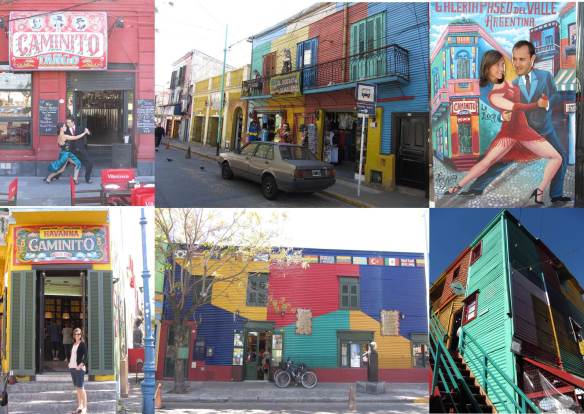
La Boca. Top left – the real tango. Top right – the fake tango.
We took a bus back to our hostel to pick up our bags, and then headed straight for the bus terminal. We managed to book an overnight cama bus to Tucuman with the Vosa company, who had a special going of AR$370 pp instead of the usual AR$500 pp. The Vosa bus was not as comfortable as the Via Bariloche bus, but is was still decent and the bus food was slightly better.
We arrived in Tucuman the next morning and decided to go onwards to Cafayate the same day (Tucuman did not seem like a very pretty town, but we only saw the older part of the town around the bus terminal). The semi-cama bus to Cafayate left at 2pm and Lonely Planet said it would only take 4 hours to our destination. It turned out to be an 8 hour drive up to Cafayate. At least the scenery along the way was beautiful!
I have to admit, our experience in Buenos Aires wasn’t so positive compared to Rio. With the exception of the tango experience, we felt like tourists in another big city that is great for shopping and has some nice landmarks. The CouchSurfing at Marcos and Ludmilla made our stay in Rio much more special. It is amazing how people contribute to ones experience of a place (and I guess life as well). It’s almost as if they let you see the place (or life) through different eyes. Buenos Aires and Rio, like most other cities, has their own problems of poverty, crime and polution. The atmosphere in Rio, however, was different and more relaxed. Almost, if I may, like Cape Town compared to Johannesburg. We are so thankful that nothing bad happened to us in Buenos Aires compared to so many other tourists visiting the city.
Psalm 30:12
12 To the end that my glory may sing praise to You and not be silent. O Lord my God, I will give thanks to You forever.
Psalm 91:2
2 I will say of the Lord, “He is my refuge and my fortress; My God, in Him I will trust.”







